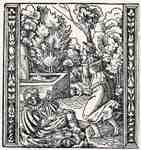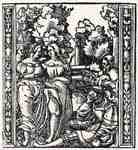Peter Flötner
Illustrations
















Bedstead with skull coat of arms

Bedstead with two putti at the head end






The captain and his two servants







The parable of selfishness and charity




Three ornament strips with unicorns, cornucopias and half-figures

Draft Pilasterbasis and a capital with leaf mask

Draft Pilasterbasis and a capital with a sphinx

Draft Pilasterbasis and a capital with vase

Draft Pilasterbasis and a capital with two sphinxes

Draft column base and a capital with a vase

Draft column base and a capital with angel head

Draft column base and a capital with half-length

Draft column base and a capital with Putti




Intarsia design: architecture with Bathsheba







Cup with representation of Lucretia



State bed box with double canopy


Cross filling with Delphi heads and cross filling with medallions

Column with a lion's head on Capital




Triumphal Arch, built in Nuremberg on the occasion of the entrance of Emperor Charles V


Door with a view into a kitchen

Tyranny, usury, apparent brightness


Template for an intarsia with six Putti

Template for an intarsia with two putti






Two cross fillings with Moorish
---
Fine Art Prints | Greeting Cards | Phone Cases | Lifestyle | Face Masks | Men's , Women' Apparel | Home Decor | jigsaw puzzles | Notebooks | Tapestries | ...
---
Peter Flötner, also Flatner, Flettner, or Floetner (born around 1490 in Thurgau, died 23 October 1546 in Nuremberg) was a German designer, sculptor, and printmaker. He was an important figure in the introduction of Italianate Renaissance design to sculpture and the decorative arts in Germany, competing in this regard with the Vischer Family of Nuremberg. He designed and produced work in a wide range of media, but "seems to have made only a modest living", unlike many of his contemporary artists.
Life and work
Flötner probably trained as a goldsmith in Augsburg with Adolf Daucher. Under his master's guidance he contributed to the goldwork in the Fugger Chapel. After an interlude in Italy, he became a master craftsman in Ansbach. He moved to Nuremberg in 1522 and took the Bürgereid ((German) "Citizen oath"), described as a sculptor.
Two of his most important free-standing sculptures are a 34.5 cm tall limewood figure of a nude man, possibly Adam, in the Kunsthistorisches Museum in Vienna, his only surviving signed sculpture,[3] and the figure of Apollo firing a bow on the Apollo Fountain (1532). The fountain was made for the Herrenschiesshaus in Nuremberg, and cast in bronze by Pankraz Labenwolf.[3]
As a printmaker he produced prints for other artists or artisans to follow as patterns: designs for furniture, altarpiece surrounds, or goldwork, and panels of ornament, as well as book illustrations, playing cards, and a decorative alphabet.[4] He became increasingly a designer of works that were actually made by others, even in media such as gold or bronze that he was trained in himself. Reliefs, medals and similar objects were modelled in carved wood or wax, with drawings for other types of object. Small easily portable metal relief plaques and statuettes were produced in editions and, like his prints, played an important part in disseminating Italianate style across Northern Europe, following the pattern begun by the prints of Nuremberg's most famous artist, Albrecht Dürer.[5] His plaques appear in a variety of metals, but most often brass, though lead, bronze and gilded ones (illustrated) are also found. At least 17 examples of one design are known.[6] A collection of his prints and designs, the Kunstbuch, was published after his death in 1549.
He designed the sculptural decoration, and possibly the architecture, of the Hirschvogelhaus (destroyed in 1945)[3] and the Tucherschloss villa in Nuremberg. He also made the triumphal arch of Emperor Charles V (no longer standing) and may have contributed to parts of Heidelberg Castle.
Flötner was also interested in Vitruvius's scientific work. Two years after Flötner's death, Petrejus of Nuremberg published the first German translation of Vitruvius, largely on the back of Peter Flötner's previous work. Like Dürer and other artists, he is buried in the Johannisfriedhof cemetery.
Flötner received most attention around 1900. He was seen as one of the finest German architects of his time and a pioneer of Italianesque architecture in the north. Braun (see "sources") emphasized Flötner's importance for Renaissance art, and said "genius" was not too much praise for him. There was a 1945 exhibition of his work in the German National Museum.
Works designed
Choir stalls and organ in the chapel of Fugger in Augsburg, Germany - 1516-18
Fountain in Mainz, 1526
Apollo Fountain in Nuremberg, 1532
Hirsvogelsaal (Hirschvogel Hall), composition, and interior
Triumphal arch of Emperor Charles V, Nuremberg - 1541
Ottheinrichsbau (design of the facade) of the Heidelberg Castle (not certain) 1546–50
Notes
This article was translated from its equivalent in the German Wikipedia on 18 July 2009.
(German) Die kleine Enzyklopädie, Encyclios-Verlag, Zürich, 1950, Vol 1, p. 522
Shultz, 473
Rowlands, John (1988). The Age of Dürer and Holbein: German Drawings 1400-1550. London: British Museum Publications. pp. 124–5. ISBN 0-7141-1639-4.
Decorative alphabet
Two plaques in the Metropolitan Museum of Art
Scultz, 445
References
Schultz, Ellen (ed). Gothic and Renaissance Art in Nuremberg, 1986, New York, Metropolitan Museum of Art, ISBN 978-0-87099-466-1
(German) Dr. Konrad Lange: Peter Flötner, ein Bahnbrecher der deutschen Renaissance, Grote-Verlag Berlin 1897
(German) E.F. Bange: Peter Flötner, Meister der Graphik Band XIV, Leipzig 1926
(German) Prof. Dr. Edmund Braun: Peter Flötner, Verlag Karl Ulrich, Nürnberg 1950
(German) J. Reimers: Peter Flötner nach seinen Handzeichnungen und Holzschnitten, Sirth's Kunstverlag, Leipzig 1890
(German) Albrecht Haupt: Peter Flettner, der erste Meister des Ottheinrichsbaus zu Heidelberg, Leipzig 1904
(German) Barbara Dienst: Der Kosmos des Peter Flötner. Eine Bildwelt der Renaissance in Deutschland. Deutscher Kunstverlag, München und Berlin 2002, ISBN 3-422-06330-7 (zugl. Dissertation, Universität Jena 1998)
(German) Joachim Thiel: Peter Flötner und sein architektonisches Oeuvre in 'Der Hirschvogelsaal (Hirsvogelsaal) - Festarchitektur des 16. Jahrhunderts', Nürnberg und München 1986
Artist
A - B - C - D - E - F - G - H - I - J - K - L - M -
N - O - P - Q - R - S - T - U - V - W - X - Y - Z
Retrieved from "http://en.wikipedia.org/"
All text is available under the terms of the GNU Free Documentation License


